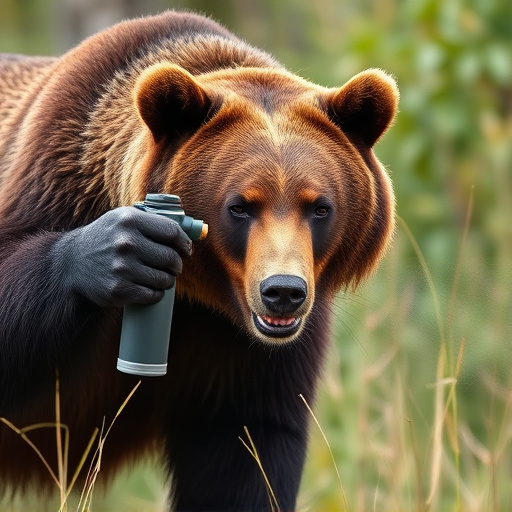Understanding bear spray fog pattern test results is crucial for outdoor enthusiasts navigating bear-active areas, as it reveals the range and effectiveness of bear spray under various conditions. Manufacturers use these data to assert product ranges, but real-world application varies based on wind speed, terrain, and spray angle. The Bear Spray Fog Pattern Test typically shows effectiveness up to 30 feet (9 meters), but proper deployment techniques, including aiming for the bear's face within this range and practicing in controlled environments, are key to enhancing safety during bear encounters.
“Unraveling the power of bear spray as a vital tool for personal safety in wild encounters, this article delves into the science behind its effective deterrent range. By examining comprehensive ‘Bear Spray Fog Pattern Test’ results, we explore factors influencing spray performance, including distance and environmental conditions. Understanding these key elements is crucial for maximizing protection during outdoor adventures in bear country. From test insights to safety tips, this guide ensures you’re equipped with knowledge to make informed decisions.”
- Understanding Bear Spray Fog Pattern Test Results
- Factors Influencing Bear Spray Range and Efficacy
- Effective Deterrent Range: What Does the Science Say?
- Maximizing Bear Spray Safety and Protection
Understanding Bear Spray Fog Pattern Test Results
Understanding Bear Spray Fog Pattern Test Results
When evaluating bear spray, one key metric to consider is the fog pattern created upon activation. Bear spray fog pattern tests simulate real-world scenarios by measuring the range and effectiveness of the spray mist under various conditions. These tests often involve releasing the spray into controlled environments, such as wind tunnels or open fields, to observe how the fog disperses. The results provide valuable insights into the potential reach and coverage of the bear spray, allowing users to make informed decisions about their safety in grizzly country.
By analyzing these test data, manufacturers can assert the effective deterrent range of their products—the distance at which the spray mist is capable of deterring an approaching bear. This information is crucial for hikers, campers, and outdoor enthusiasts navigating areas known for bear activity. Understanding the fog pattern helps users anticipate the spray’s performance in different scenarios, ensuring they have a reliable tool to protect themselves during encounters with these powerful animals.
Factors Influencing Bear Spray Range and Efficacy
The effectiveness of bear spray as a deterrent is greatly influenced by several factors. One key aspect is the spray’s fog pattern, which can vary between products. The Bear Spray Fog Pattern Test provides valuable insights into how far and wide the spray reaches, crucial for determining its potential to protect against bears. Factors like wind speed and direction play a significant role; a gentle breeze can carry bear spray much further than expected, while a strong gust might cause it to dissipate more quickly.
Additionally, the terrain’s topography matters. In open areas, bear spray can travel farther, but in dense forests or mountainous regions, trees and slopes can disrupt the fog pattern. The distance at which the spray remains effective also depends on the concentration of capsaicin, the active ingredient in bear spray, and how it interacts with environmental conditions. Understanding these factors is essential for users to make informed decisions when choosing bear spray as a deterrent in various settings.
Effective Deterrent Range: What Does the Science Say?
The effectiveness of bear spray as a deterrent is often measured by its range—how far it can reach and still be potent enough to deter an approaching bear. The ‘fog pattern test’ is a scientific approach used to gauge this range. This method involves releasing a controlled amount of bear spray into the air and measuring the dispersion and density of the fog particles over time.
Studies have shown that bear spray can be effective up to 30 feet (approximately 9 meters) in ideal conditions, but real-world scenarios often present variables like wind speed and direction, terrain, and the angle at which the spray is directed, all of which can impact the range. Therefore, while the fog pattern test provides valuable data, it’s crucial to understand that the effective deterrent range can vary significantly based on these factors.
Maximizing Bear Spray Safety and Protection
Maximizing Bear Spray Safety and Protection requires a deep understanding of its effective range and application technique. One crucial factor is the bear spray fog pattern test, which helps determine how far the spray reaches and where it settles. This knowledge ensures users can deploy the spray optimally, covering their escape route or potential refuge areas.
When using bear spray, it’s essential to aim for the face and eyes of the approaching bear. The ideal range for maximum effectiveness is typically around 20 to 30 feet (6 to 9 meters), but this can vary based on factors like weather conditions and the bear’s behavior. Practicing with bear spray in controlled environments before encountering a real bear can significantly improve safety, ensuring users are familiar with the spray’s reach and impact.
Bear spray fog pattern test results reveal that an effective range of deterrence depends on several factors. Understanding these variables, such as wind speed and direction, terrain, and the angle of application, is crucial for maximizing bear spray safety and protection in unpredictable wilderness encounters. By knowing the science behind bear spray range and efficacy, outdoor enthusiasts can make informed decisions to ensure their safety in bear country.
